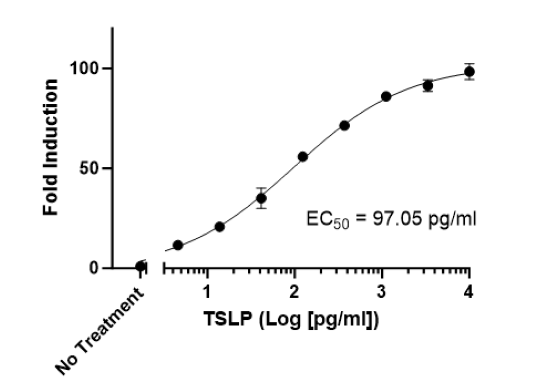TSLP Responsive Luciferase Reporter Ba/F3 Cell Line
The TSLP Responsive Luciferase Reporter Ba/F3 Cell Line is a murine Ba/F3 cell line engineered to express both TSLP-R (thymic stromal lymphopoietin receptor, also known as CRLF2, cytokine receptor like factor 2) (NM_022148.4) and IL-7Ra (Interleukin 7 receptor alpha) (NM_002185.5) separated by a self-cleaving P2A peptide. The construct was delivered bytransduction of STAT5 Luciferase Reporter Ba/F3 cells (#79772), which express a firefly luciferase reporter driven by STAT5 response elements located upstream of the minimal TATA promoter. After activation by TSLP, the endogenous transcription factor STAT5 binds to the response elements, inducing transcription of the luciferase reporter gene.
This cell line has been validated to respond to TSLP. Additional functional validation demonstrates that TSLP-induced luciferase activity can be inhibited by either anti-TSLP or anti-TSLPR neutralizing antibodies.

Figure 1: Illustration of the mechanism of TSLP Luciferase Reporter Ba/F3 Cell Line.
TSLP binds to TSLPR, recruits the IL-7Ra co-receptor and activates downstream JAK1/2 (janus kinase 1/2) tyrosine kinases, which phosphorylate the transcription factor STAT5. STAT5 phosphorylation triggers the formation of a homodimer and translocation to the nucleus, where it can activate the transcription of the Firefly luciferase reporter driven by STAT5 response elements present in the promoter.
Interested in screening and profiling inhibitors or blocking antibodies in the TSLP cell culture assay without the need to purchase and license the cell line? Check out our Cell Signaling Pathway Screening.
Purchase of this cell line is for research purposes only; commercial use requires a separate license. View the full terms and conditions.
Media Required for Cell Culture
| Name | Ordering Information |
| Thaw Medium 8 | BPS Bioscience #79652 |
| Mouse Interleukin-3 Recombinant | BPS Bioscience #90189 |
| Growth Medium 8C | BPS Bioscience #82505 |
Materials Required for Cellular Assay
| Name | Ordering Information |
| Assay Medium: Thaw Medium 8 | BPS Bioscience #79652 |
| Recombinant Human TSLP Protein | R&D Systems #1398-TS-010/CF |
| Anti-TSLP Neutralizing Antibody | BPS Bioscience #102138 |
| ONE-Step™ Luciferase Assay System | BPS Bioscience #60690 |
| White, clear-bottom 96-well tissue culture plate | Corning #3610 |
| Luminometer |
The cell line has been screened to confirm the absence of Mycoplasma species.
TSLP (thymic stromal lymphopoietin) is a protein that functions as a type I cytokine, as an alarmin and growth factor in the immune system. It is involved in type 2 immune responses, TH2 (T helper 2 cells) responses, and the maturation and recruitment of dendritic cells (DCs), T cells, B cells, neutrophils, mast cells, and other lymphoid cells. It can be produced by epithelial and stromal cells in lung, skin, and gastric system, but also by DCs, basophils and mast cells. Its expression can be induced by infections, pro-inflammatory cytokines, proteases, and even mechanical injury. For instance, it can be produced in the lungs in response to infection with influenza or rhinovirus. Its role as alarmin can result in increasing inflammation. TSLP is linked to allergic reactions such as asthma, atopic dermatitis, and food allergies, by inducing the expression of OX40L, CD80 and CD86 and stimulating CD4+ T cells. TSLP signals through a heterodimeric receptor of TSLP-R (CRLF2) and IL7Ra (CD127), and via downstream activation of JAK2/STAT5 signaling. In 2021, the TLSP-neutralizing antibody tezepelumab was approved for the treatment of severe asthma. Targeting TSLP is an active area of investigation with ongoing clinical trials for the treatment of autoimmune disorders.
Ebina-Shibuya R. and Leonard WJ. 2023 Nat Rev Immunol, 23: 24–37
Marković I. and Savvides S., 2020 Front. Immunol., 11.
Palacios R. et al., 1984 Nature 309 (5964): 126-131.
Rochman Y., Spolski R. and Leonard, W., 2009 Nat Rev Immunol, 9: 480–490.
Verstraete K. et al., 2014 Nat Struct Mol Biol, 21: 375–382.




